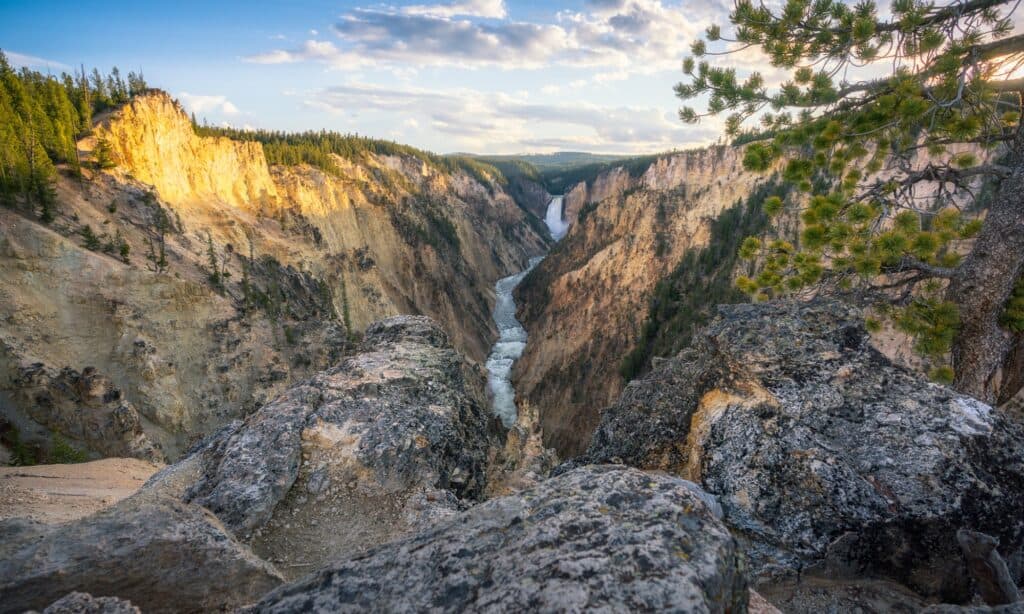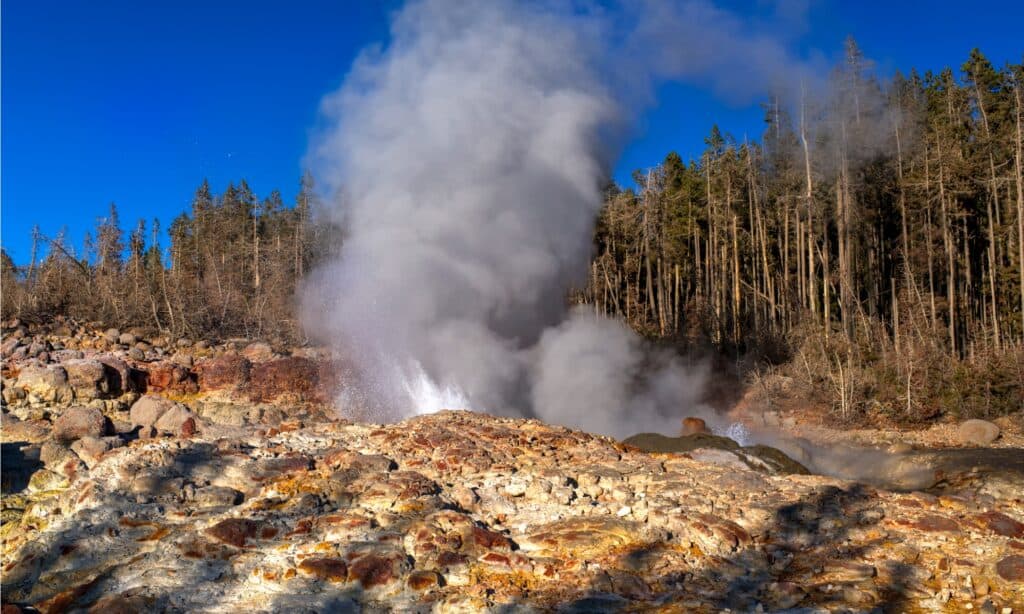Yellowstone National Park has a long and varied history involving hydrothermal features and volcanic eruptions, which begs the question: how big is the Yellowstone Volcano? If you are interested in seeing evidence of volcanic eruptions and want to know more about how Yellowstone National Park formed, you’re in the right place.
In this article, we will tell you just how big the Yellowstone Volcano is as well as where you can see evidence of volcanic activity within Yellowstone National Park. We will also go over Yellowstone’s volcanic history and how this natural landscape formed, millions of years ago. Let’s get started and learn all about Yellowstone now!
Size of the Yellowstone Volcano: How Big is it?

Yellowstone’s volcanic history begins as far back as 2.1 million years ago.
©iStock.com/ChrisB
Technically considered a supervolcano, the Yellowstone Volcano is roughly 30 by 45 miles in size. However, the Yellowstone Volcano is technically known as the Yellowstone Caldera nowadays, given the fact that every single time this supervolcano erupted, it formed calderas, devastating craters and huge holes in the earth due to the force of volcanic explosions.
Scientists have studied just how much magma and volcanic substance lies under the earth in Yellowstone National Park. These vast chambers are full of two distinct magma layers: rhyolite and basalt. Rhyolite forms the upper layer, going about 7 miles deep and 25 miles across. The next layer of basalt is much larger, with nearly 18 miles of substance.
When you consider just how large these magma chambers are, it’s no wonder that Yellowstone has had a number of volcanic events in its history. While these chambers are not dormant, the Yellowstone Volcano is not likely to erupt in our lifetime, and likely won’t erupt for thousands of years. Volcanoes have a lifespan and a certain amount of energy within their magma chambers, and most of the magma found underneath Yellowstone National Park is compacted and solid.
Yellowstone’s Volcanic History

Given the fact that the Yellowstone Volcano erupted and collapsed in on itself multiple times during its million-year history, you can’t technically see the Yellowstone Volcano.
©iStock.com/Teri Lee in Print
Yellowstone’s volcanic history begins as far back as 2.1 million years ago. This was the time that the very first Yellowstone super eruption occurred, with a devastating amount of force and debris. This eruption formed one of 3 calderas within Yellowstone National Park boundaries, but this was just the beginning.
The second eruption occurred 1.3 million years ago and formed a caldera located partially outside Yellowstone National Park boundaries. The third and final eruption that occurred 630,000 years ago created the Yellowstone Caldera that we know and love today, centrally located and visible from certain locations.
Speaking of where it is visible, you may be wondering where you can see the Yellowstone Volcano, or rather the Yellowstone Caldera. Let’s take a moment to discuss the types of volcanic activity you can see throughout Yellowstone National Park, as well as if you can see any evidence of this violent and beautiful volcano during your visit.
Can I See the Yellowstone Volcano?

The third and final eruption that occurred 630,000 years ago created the Yellowstone Caldera that we know and love today.
©iStock.com/BigshotD3
Given the fact that the Yellowstone Volcano erupted and collapsed in on itself multiple times during its million-year history, you can’t technically see the Yellowstone Volcano. However, you can see evidence of its destruction in certain locations in the park, including a few locations that have resurgent domes.
For example, the Yellowstone Caldera is visible from a few different locations in the park, though you may need to enjoy a lovely hike in order to get the best view. Thankfully, this area of the park is very centrally-located, and not only is it possible to see a resurgent dome within the depths of Yellowstone Lake, there are a number of other volcanic features that you can see in this region of park. Let’s talk about that now.
Evidence of Volcanic Activity in Yellowstone National Park

The Yellowstone Caldera is visible from a few different locations in the park, though you may need to enjoy a lovely hike in order to get the best view.
©iStock.com/SergeYatunin
All of Yellowstone National Park is built upon volcanic activity, so there is plenty of evidence of this for you to see it during your visit to the park. For example, The Yellowstone Volcano wasn’t the only volcano in this particular region, as the Absaroka Mountains formed a number of volcanic features millions of years before the Yellowstone Volcano erupted- including this unique and haunting petrified forest!
Not only are the geysers found within Yellowstone National Park direct evidence as to its volcanic history, but you can also see the following volcanic features during your visit:
- Basalt
- Ash flow and deposits
- Lava flow
- Tuff (volcanic ash rocks)
- Rhyolite
- Caldera rims, basins, and other features
All of these fantastic features can be seen in the Yellowstone Caldera area of the park. If you are specifically looking for views of the resurgent dome or evidence of the super eruptions long past, you should definitely check out the following locations:
- Firehole Canyon- lava flows along the Firehole River
- Lewis Falls- close enough to the Caldera rim for a good look
- Washburn Hot Springs Overlook- a fantastic view of the Caldera and a resurgent dome
- Obsidian Cliff- lava flows are possible here
- Gibbon Falls- Check out the Caldera rim from this spot
- Tuff Cliff- unique ash flows and rock formations
- Sheepeater Cliff- beautiful columns of basalt form unique structures
No matter what your plans are when visiting Yellowstone National Park, you will see volcanic evidence anywhere you go. While it may not be as spectacular as a standing volcano, the Yellowstone Caldera is a beautiful location to visit, and you can’t go wrong looking at waterfalls and geysers either!
The photo featured at the top of this post is © iStock.com/rmbarricarte
Thank you for reading! Have some feedback for us? Contact the AZ Animals editorial team.







